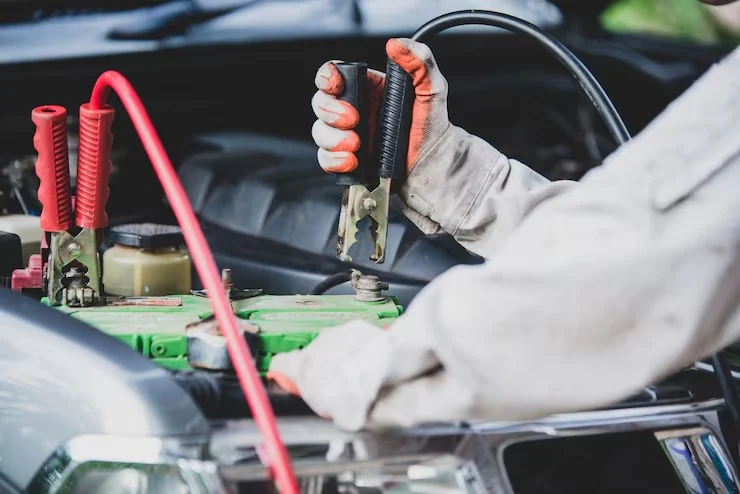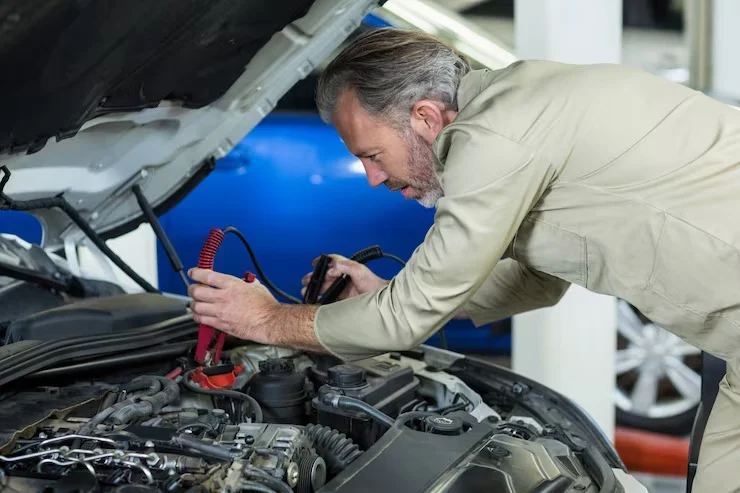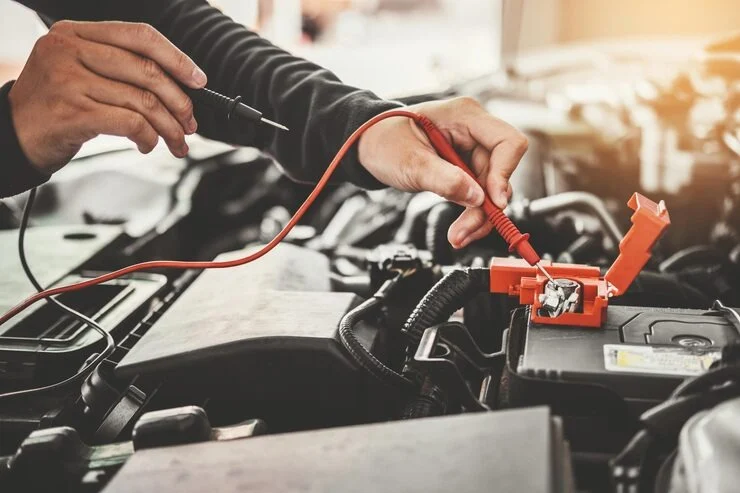Electric vehicles have become a major part of the automotive landscape in a short amount of time. With faster service, reduced environmental issues, and a wider variety of models, the EVs by Tesla, Nissan, and Chevrolet have surely taken the limelight. Yet, just like gas cars, electric vehicles do at times suffer from some battery-related problems. One common question among electric car owners is: Can you jump-start an electric car? The relevance increases when the big EV battery is low on charge, or the car has been sitting idle for too long.
In this article, we discuss whether it is possible to jump-start an electric car, the precautions to take, and whether a Tesla can jump-start any other vehicle.

Can You Jump-Start an Electric Car?
Jump-starting an internal combustion engine vehicle is fairly simple: using jumper cables connects a dead battery to a fully charged one, and the engine turns over. What these cars fail to explain is that electric cars work quite differently from gasoline-powered ones, thereby making one think a little about jump-starting.
Electric vehicles operate on high-voltage lithium-ion batteries that operate quite differently from the traditional 12-volt batteries casing a conventional car. Because of this, jump-starting an EV cannot be a mere case of connecting cables from one car’s battery to another. Most EVs are simply not designed to be jump-started in the traditional sense.
What Happens If an Electric Car Battery Dies?
A 12-volt battery dying in an electric car means that the essential car systems stop functioning: the car will have no light, no infotainment, no power steering, and no electrical assistant functionalities. In this case, the car will not start, and the high-voltage battery, which powers the electric motor, will also be inaccessible.
The difference between this and a traditional gasoline car is that the electric car motor is not powered by this 12-volt battery directly. While the high-voltage battery powers the car’s drive motor, it is this 12-volt battery that powers the vehicle’s electrical systems. The 12-volt battery might be flat, and your car might not turn on.
More often than not, however, such an issue should be fixed by jumping the 12-volt battery, not the high-voltage one. Yet, there may be exceptions since some cars may be able to articulate their electrical systems in a more complicated way, which could either freeze or foil your attempts to jump-start them as you would with your gas car.
Jump-Starting an Electric Car? How to Do It
Jump-starting the 12-volt battery of an electric car is theoretically possible, like with all vehicles, but must be done with caution and a thorough understanding of the proper procedure. Here’s a step-by-step guide to jump-starting the 12-volt battery of an electric car.
Step 1: Assess the Situation
Before jumping an electric car, one must assess if the problem rests with the 12-volt battery. Jumping is futile if the high-voltage battery is low or if the car is simply not charging because of some other fault. In such instances, there may be a need for professional intervention in fixing the car.
Step 2: Gather Necessary Equipment
The equipment you would need for this type of jump-start is:
– Jumper cables (preferably heavy-duty and of good length).
– Any vehicle from which to gain a fully charged 12-volt battery.
– Both vehicles should be parked close enough so the jumper cables can reach from the one battery to the other.
– Gloves and goggles for personal protection.
Step 3: Find the 12-Volt Battery
The 12-volt battery is generally located in a compartment under the front or rear trunk in most electric vehicles (the “frunk,” in some EV terminologies). Still, the exact location can vary according to the make and model of the electric car. Check the owner’s manual or research online for help if unsure.
Step 4: Connect the Jumper Cables
Turn off both cars for safety.
Attach one red clamp to the positive terminal (+) of the electric car’s 12-volt battery.
Attach the other red clamp to the positive terminal (+) of the donor car’s battery.
Attach one black clamp to the negative terminal (-) of the donor car’s battery.
Attach the other black clamp to an unpainted metal surface of the electric car (e.g., a bolt or engine block). Never attach the negative clamp directly to the 12-volt battery, as sparks may be generated.

Step 5: Start the Donor Car
Start the donor car and allow it to run for a few minutes. This allows the donor car’s battery to supply some charge to the electric vehicle’s 12-volt battery.
Step 6: Start the Electric Vehicle
After a few minutes, try to start the electric car. If the 12-volt battery is just low on charge, the car should power up. You will probably see some systems booting up before the motor lamps come on. If the 12-volt battery is dead flat, it might take longer than the jumping process, or the donor car might just not be able to provide the necessary power.
Step 7: Remove the Jumper Cables
When the electric vehicle starts, slowly remove the jumper cables in the following order:
Remove the black clamp that is attached to the metal surface of the EV.
Remove the black clamp from the donor car’s negative terminal.
Remove the red clamp from the donor car’s positive terminal.
Lastly, remove the red clamp from the EV’s positive terminal.
Keep the electric vehicle on for a while so that the 12-volt battery gets some charge. If it does not start or the problem repeats, the 12-volt battery might have to be replaced.
Safety Tips for Jump-starting Electric Procedures for Jump-Start an Electric Car
The act of jump-starting an electric car, or any vehicle for that matter, carries its share of risks. This list of safety pointers must be carefully considered and carried out to ensure the proper handling of the issue without any harm to oneself or the vehicle.
Understand the Vehicle Warranty: Always check the manufacturer’s recommendations in the owner’s manual before attempting to jump-start an electric car. Some EVs/discourage jump-starting or recommend that you let some professionals handle it: K.
Beware of High-Voltage Battery: The high-voltage battery in an EV is very dangerous if mishandled. Never attempt to jump-start or attach jumper cables to the high-voltage battery, or else you will give cause for a short-circuit to occur and severe injury to yourself.

Inspect the Cables: Ensure that the jumper cables you are using have no frays or cuts. Damaged cables can generate sparks, leading to an explosion or fire.
Avoid Sparks: Sparks happen when cables are not connected properly or the clamps touch. Before attempting to start the car, ensure the connections are secure.
Use Safety Equipment: Not mandatory, but using gloves and goggles can give you an extra layer of protection. When handling potentially dangerous equipment, it’s best to be safe.
Can a Tesla give a Jump-Start?
Tesla owners asked, “Can a Tesla jump-start another car?” In answer to which it’s simple: Yes, but with restrictions.
The cars have 12V batteries that supply power to electric systems such as lighting, infotainment, and power locks. When an emergency occurs, jump-starting another car from a Tesla can be done as easily as any other vehicle equipped with a 12V battery.
However, for one, the battery in the Tesla is designed to serve its functions internally and not to offer power to England. While it can give a jump-start in emergencies, doing so is not the best for the longevity of the car’s battery, so it’s best to find a dedicated jump starter pack for this purpose or use the 12-volt battery inside a conventional petrol car.
Moreover, the act of using a Tesla to jump-start another car could cause some warranty claims to be voided; thus, make sure you double-check in your owner’s manual and have a conversation with Tesla support before you do anything.
Conclusion
In most scenarios, though operating and functioning quite differently from conventional petroleum-dependent cars, electric cars still can have their 12-volt battery jump-started. This should, however, be done cautiously and concerning the protocols essential for safety. Never forget that the high-voltage battery cannot be jump-started since these batteries are quite specialized and are to be handled by expert technicians only.
Go through your manual before initiating a jump-start on your EV. In cases where you have some doubts or are not successful in jump-starting your car, professional roadside assistance should be called immediately. Well-cared B 12-volt battery of your electric car would prevent situations warranting jump-starts in the first place.
And for Tesla owners who’ve been wondering if they could use their car to jump-start another vehicle, remember it is possible, though it may not be in the best interest of your car in the long term. Only use this option if necessary, and make sure you’re doing it the right way to prevent any damage to your car or harm to yourself.


